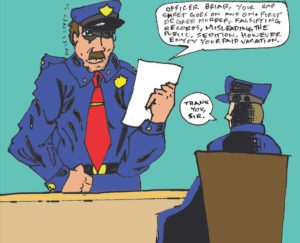N/A
October 24, 2022 – November 4, 2022
elin o’Hara slavick
CATHARSES / ANTIDOTES
Oct 24 – Nov 4, 2022
The series of diptychs that make up elin o’Hara slavick’s Window Dressing installation, Catharses/Antidotes, began as a therapeutic attempt to purge her mind of recurring negative thoughts. When she first read the student evaluations from the very last course of her nearly three decade-long career as an art professor, slavick nearly vomited. These comments haunted her, keeping her up at night (surprise, surprise, teachers are human too). After asking friends how to keep these kinds of thoughts from overtaking her sense of self-worth, she received conflicting suggestions. Some told her to train her brain to banish bad thoughts, while others suggested therapy, exercise, something called EDMR (Eye Movement Desensitization and Reprocessing), or even just a stiff drink. But after listening to Krista Tippett’s On Being podcast, she concluded that the best response would be “to sit with the feelings; to write it all down; to focus on and process the negative to get to the other side, to get through it.” Thus began an extended project to sit and paint the very words that had disturbed her. A state of liberation set in. Suddenly, insults became compliments, jokes, and reflections on – and revelations of – the speakers. Posting these text paintings on social media - sharing her dirty laundry, so to speak - helped her to let go, and suddenly others were doing the same. Of the 100 Catharses paintings in her series, the first 28 come from statements made to her, but the rest come from reported commentary addressed to others. For each, she composed an accompanying Antidote, a cure made from the very poison it defends against. She realized that words such as these have been said to many other people and, in fact, worse things have been uttered, screamed, and whispered before. She is not unique, which makes the hurt less painful to endure and the feeling all the more relatable to others. While aesthetically these drawings may be considered ‘bad art’ in a traditional academic sense, lots of the best art, the pieces that stay with us, are made from the difficulties of our world, the struggle, the icky parts. In citing numerous text-based artists as influential precedents for this project - from Ed Ruscha and Deb Kass to John Baldessari and Jenny Holzer - the artist particularly highlights Tracey Emin, for her darkly humorous and sincerely personal confessions, and Barbara Kruger, for her ambiguous use of genderless pronouns, such as YOU and I, that inevitably implicate and/or address the viewer. Anyone could be on the receiving end and/or originating expression of these statements and, in particular, they could be about anyone existing in an unequal power dynamic: president/citizen, boss/employee, teacher/student, husband/wife, parent/child, enemy/friend. However, while amplifying the words, the Catharses paintings also subvert their very meaning. And the Antidotes, by answering (or arguing against) each negative comment, offer a solution, a gesture towards peaceful resolution, a balm for deep wounds. If, as Sarah Schuman says, “conflict is not abuse,” these diptychs seek to reveal the conflict in order to avoid the abuse, and engage in the deep psychological work required for healthy discourse.
elin o’Hara slavick is an Artist-in-Residence at the University of California, Irvine. She was a Professor of Studio Art, Theory and Practice at the University of North Carolina, Chapel Hill from 1994 until 2021. Her interdisciplinary work critically explores war, memory, exposure, memorials, cartography, history, labor, feminism, the body, politics and utopia/dystopia. Slavick has exhibited her work internationally, and her work is held in many collections, including the Queens Museum, The National Library of France, The Library of Congress, The Nasher Museum of Art and the Art Institute of Chicago. She was previously represented by Cohen Gallery in LA. Slavick is the author of two monographs - Bomb After Bomb: A Violent Cartography with a foreword by Howard Zinn, and After Hiroshima, with an essay by James Elkins; a chapbook of surrealist poetry, Cameramouth; and Holding History in Our Hand for the 75th commemoration of Hiroshima and Nagasaki. She has held artist residencies in Canada, France, the Unites States and Japan, most recently as a Huntington Art Fellow at Caltech. Her work has been featured in the New York Times, Los Angeles Times, Images Magazine, FOAM, San Francisco Chronicle, Asia-Pacific Journal, Photo-Eye, and Actuphoto: Actualite Photographique, among other publications. She lives in Irvine, California with her epidemiologist husband Dr. David Richardson, two children, a dog and a cat.



